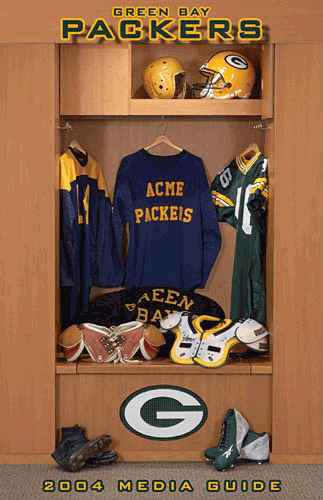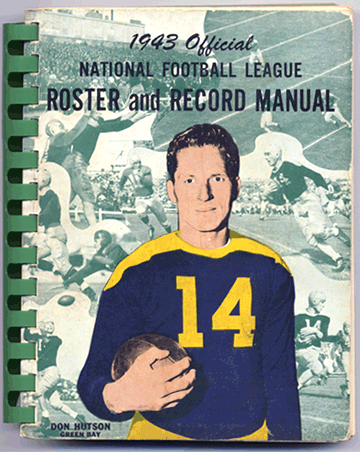| Year |
Uniform |
| 1919 |
Solid navy jerseys, gold pants, no numbers (HIST
I, photo) 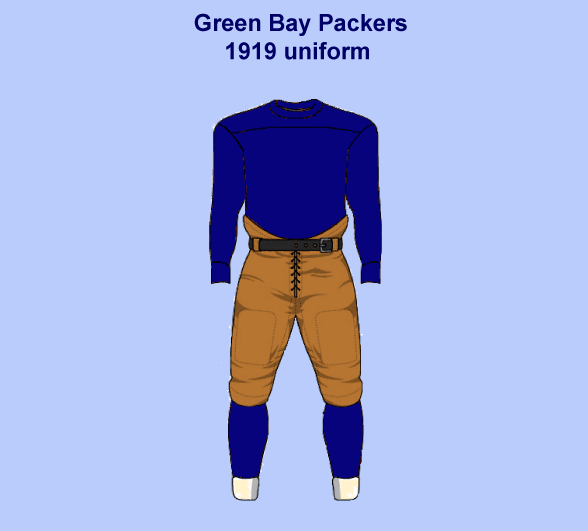
|
| 1920 |
No new changes to uniform (HIST I,
photo) |
| 1921 |
Dark blue jerseys with "ACME PACKERS" in gold across the front,
gold pants, no numbers (GBP03; 501)
Note: in the book "Packers by the Numbers," the lettering is listed
as being white, not gold. This is likely a mistake, as all other sources
depict the lettering as gold. |
| 1922 |
|
| 1923 |
Gold jersey with nine thin navy stripes on each sleeve, gold leggings,
dark gold pants Click here for a picture (Curly Lambeau) (GBP03; 501) |
| 1924 |
No new changes to uniform (HIST I,
photo) |
| 1925 |
Introduction of uniform numbers; dark gold shirts with
wide navy blue stripe covering shoulder and collar extending to top of
each arm; tall gold
leggings, light gold pants (GBP03; 501) |
| 1926 |
No new changes to uniform (HIST I, photo) |
| 1927 |
Elaborate, jockey-like jerseys, with inverted triangle tracing clavicles
and 13 blue and gold vertical stripes from chest to stomach; faded blue
canvas pants, gold socks with two blue stripes (GBP03; 501) |
| 1928 |
No new changes to uniform (HIST I,
photo) |
| 1929 |
Solid navy jerseys, with small yellow circle (~ 5" diameter) containing
blue numbers on chest; solid tan pants Click here for a picture (Johnny "Blood" McNally) (HIST I, photo).
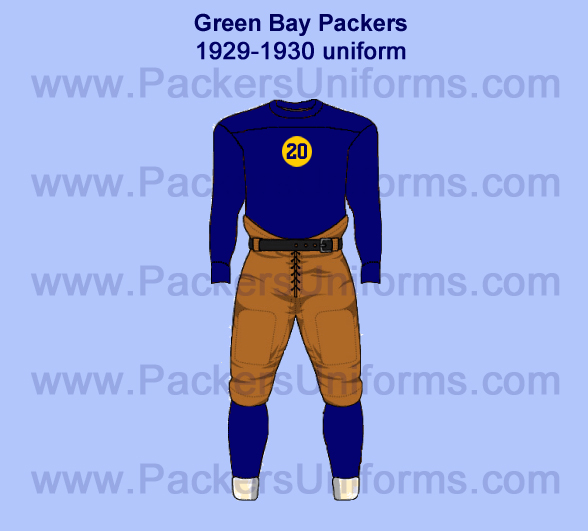
This was the inspiration for the Packers' 2010-2014 alternate uniform. |
| 1930 |
No new changes to uniform (HIST I,
photo) |
| 1931 |
Solid dark navy jerseys with white numbers on back;
gold pants; plain dark navy socks (HIST I, photo) |
| 1932 |
No new changes to uniform (HIST I,
photo) |
| 1933 |
No new changes to uniform (HIST I,
photo) |
| 1934 |
Introduction of large white numbers on chest |
| 1935 |
Introduction of first green uniform: Solid dark green
jersey with gold numbers and green pants (HIST II, p?,
photo)
Mid-season change: green jerseys with gold sleeves
and shoulders (from neck to wrist), gold numbers; gold pants, tall green
socks (HIST II, photo) |
| 1936 |
|
| 1937 |
Introduction of the classic Lambeau-era uniform: navy jersey with
gold shoulders and numbers; gold pants, blue socks; gold helmets Click here for a picture (Clarke Hinkle) (PBN)(TC). This would be the basis for the 1994 throwback home uniform (see below).
Preseason (August) game against the College All-Stars: green
jerseys with ten-inch gold numbers on front and back; gold helmets and
pants. These
uniforms
were made out of jockey satin and did not breathe; many Packers later
blamed the loss on the hot, uncomfortable uniforms (Clarke Hinkle claimed
to have lost 25 pounds during the game). (ECL)(PBN)(HIST
II)
Starting in 1937, the league mandated that all players wear numerals
a minumum of six inches high on the front of the jersey and eight inches high
on the back of the jersey (TC) |
| 1938 |
White jersey added for Cleveland game at City Stadium
to avoid confusion between the two navy-clad teams (after Halas complained
of just such confusion in the Bears' game with Cleveland) (HIST
II) |
| 1939 |
Additional alternate uniform added: Solid white jerseys with green numbers, gold pants;
white socks (PBN). Click here for details. This uniform was the basis for the throwbacks worn against Detroit on Thanksiving Day, 2001 (see below). The Packers wore the classic blue jerseys with gold yokes in the championship game with the Giants. Click here for a picture. |
| 1940 |
|
| 1941 |
|
| 1942 |
|
| 1943 |
League mandates helmet use for all players (TC) |
| 1944 |
|
| 1945 |
|
| 1946 |
Introduction of new alternate jersey, same as home but with white in
place of blue: White jersey with gold shoulders, gold numbers;
gold helmets and pants; white socks. This would be the basis of the throwback road uniform worn against the Bears at Soldier Field on Halloween Day 1994, with navy numbers instead of gold to improve legibility. |
| 1947 |
|
| 1948 |
|
| 1949 |
Dark blue jerseys, gold shoulders removed, larger gold numbers
Sideline jackets are solid navy with navy collar and cuffs, front zipper, "GREEN
BAY PACKERS" in gold on back. (photo, own) |
| 1950 |
New head coach (Gene Ronzani), new uniforms: "We are the Green Bay Packers," he said as he added green to the color scheme. Packers use three varying uniform sets in rotation:
Modern plastic helmets adopted. The switch from leather to plastic was controversial nation-wide because of accusations that they caused more injuries than they prevented, so much so that the NFL banned plastic shells in 1948 (but lifted the ban the following year). (GBP08) |
| 1951 |
|
| 1952 |
Addition of third alternate uniform: white jersey with green numbers
and pants (PBN)
When the Packers played the Rams in December 1952, both teams wore gold uniforms
and LA coach Hampton Pool played the game under protest (the Rams won 45-27). Click here for details. (PBN)
In 1952, the NFL made its first attempt to organize the assignment of jersey numbers by position (this system was formally codified in 1973 and amended in 1989) (PBN) |
| 1953 |
Brighter green shirts with same striping and thicker gold numbers; team continued to vary its combinations. The Packers also had available a white jersey, saving it mostly for late-season West Coast trips.(GBP08) |
| 1954 |
New coach (Lisle Blackbourn), new uniforms (again): solid navy blue jersey
returns, with new three-stripe design in "dirty mustard gold" on sleeves and socks; faded
gold pants. (GBP03; 501)(PBN)
Team
also experiments
(through 1958) with white uniform and helmets, with single navy stipe down
pants, and navy jerseys with white numbers and sleeve striping (GBP03; 501)(PBN)
George Halas refuses to outfit his Bears in road whites for games at City
Stadium in 1954 and 1955. As a result, both teams wear dark blue jerseys. |
| 1955 |
|
| 1956 |
For 1956 opener vs. Detroit, Packers break out green jersey with white pants and white helmets, but never wear again until '58. Team used its older green jerseys and gold pants (from the early '50s) in several road games. (GBP08) "TV numbers" added to sleeve (GBP03; 501)(PBN) |
| 1957 |
Uniform overhaul: dark bluish-green jersey with three gold bands on sleeves
and gold numbers; gold helmets and pants; green and gold striped socks
(white helmets were also worn)(PBN) In 1957, Packers began consistently wearing white on road, for television.(GBP08) |
| 1958 |
New coach Scooter McLean brings back same green uniforms used in 1956 opener (white pants, white helmet). (GBP08) |
| 1959 |
Uniform overhaul: new head coach Vince Lombardi revamps uniforms to the
familiar design still seen today with minor modifications. Original design
had no helmet logo, and called for three-stripe design on socks; all players
asked to wear the same style cleat. (GBP03; 502)
In 1959 road games only, socks above striping were white (tops of socks have been green for all games since 1960). (GBP08)
During this period, the Packers experiment with green facemasks before adopting gray through 1980. Click here for details. |
| 1960 |
|
| 1961 |
Addition of first and only helmet logo in team history, "G" logo designed
by team equipment manager Dad Braisher. (GBP03; 502)(PCOM) |
| 1962 |
|
| 1963 |
|
| 1964 |
|
| 1965 |
Most players now wearing five stripes on socks (GBP03; 502) |
| 1966 |
|
| 1967 |
|
| 1968 |
|
| 1969 |
NFL 50th anniversary patch added to
left shoulder (as seen on this Mitchell and Ness reproduction Bart Starr jersey) (GBP03; 502) |
| 1970 |
Names added to the back of the jersey (conforming to league mandate as
part of the AFL/NFL merger) (GBP03; 502) |
| 1971 |
|
| 1972 |
|
| 1973 |
|
| 1974 |
Majority of players begin wearing white shoes (GBP03; 502) |
| 1975 |
pant stripes widened by more than a inch (GBP03; 502) |
| 1976 |
|
| 1977 |
|
| 1978 |
|
| 1979 |
|
| 1980 |
Facemask changed from grey to green (GBP03; 502) |
| 1981 |
Sock striping eliinated, changed to solid green (GBP03; 502) |
| 1982 |
|
| 1983 |
|
| 1984 |
New head coach Forrest Gregg makes most changes to uniform since Lombardi
in 1959 - Logo added to each sleeve, white numbers in green oval added
to pants, gold stripe added to pants (making stripe combination green/white/gold/white/green),
TV numbers move from sleeve to shoulder, and gold/green/white/green/gold
striping added to neckline. (GBP03; 502) 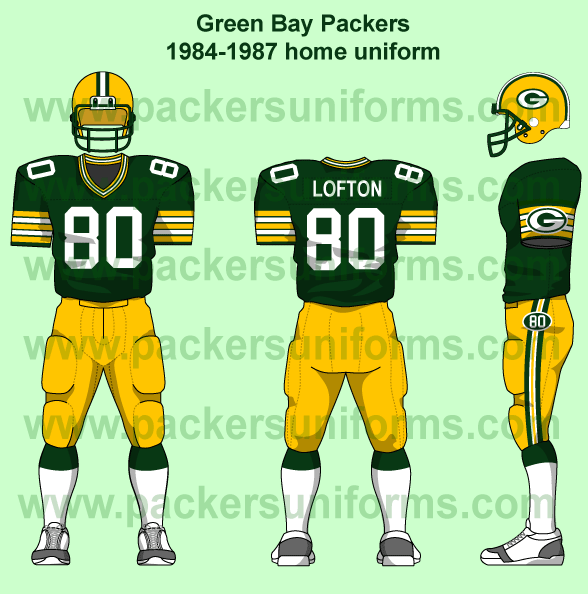
|
| 1985 |
|
| 1986 |
|
| 1987 |
|
| 1988 |
Elimination of number from pants. Single gold ring added to socks. (GBP03; 502) |
| 1989 |
Pant striping returns to pre-1984 pattern (green/white/green); elimination
of logo from sleeves (GBP03; 502).
For the first time since the 1950s, the Packers wear white jerseys at home for the first two games of the season: a 23-21 loss to Tampa Bay in Week One and a 35-34 win over New Orleans in Week Two. The Packers have not worn white jerseys in a game at Lambeau Field since. |
| 1990 |
|
| 1991 |
NFL shield added to jersey neck (GBP03; 502)(photo), manufacturer's logo (MacGregor) added to sleeve |
| 1992 |
Solid green socks added (GBP03; 502)(photo), Starter assumes contract for uniforms, their logo replaces MacGregor on the sleeves.
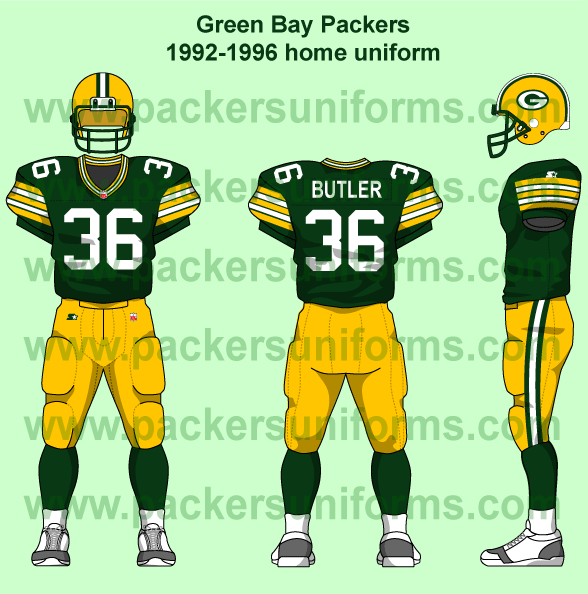
|
| 1993 |
Packers 75th anniversary patch added to left chest
(as seen on this Mitchell and Ness reproduction Reggie White jersey)
(GBP03; 502)(photo) Manufacturer's logo also appears on the pants.
NFL requires that coaches wear team-issued (and team-branded) clothing on the sidelines.
At this time, a uniform overhail was proposed. Details here are quoted from
the Packer Report, September 18, 1993:
Possible
Color Change Outlined
There was a rumor Sunday the Packers
would have a press conference concerning their uniforms colors during
the week following the Eagle game. This, however, seemed certain: The
Packers plan to change their uniforms next season, retaining the current
dark green, but switching pants and helmets from the present yellow
to metallic gold.
The Packers hope the changes will be approved by the NFL Properties
by the beginning of next month so they can wear the new uniforms next
season. Among other changes are the removal of stripes now on the helmet,
jersey, and pants.
Packer President Bob Harlan told the Milwaukee Journal the gold was
not the same as that worn by any other team and that it was selected
by General Manager Ron Wolf and Coach Mike Holmgren. Harlan said the
helmet would be switched from yellow to gold and have a large green
"G" on each side and the jersey would have a smaller green "G" on each
sleeve. The white numbers on the green home jerseys and the green numbers
on the white road jerseys will also have a gold outline. The pants will
be plain gold.
"Years and years ago, we wore a gold helmet and gold pants,"
Harlan said. "And I think that's what Ron wanted, a simpler uniform.
They didn't want to look like New Orleans or the 49ers. They looked
at different golds and picked out what they liked."
Here is my interpretation of what those new uniforms would have looked like:
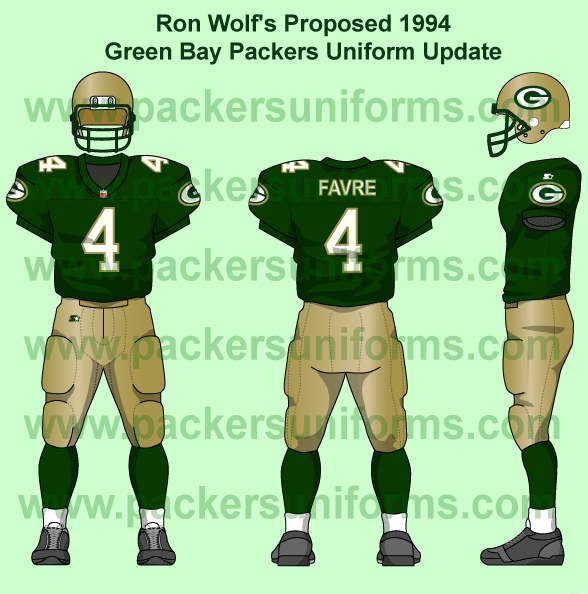
Paul Lukas, who would go on to create the indispensable Uni Watch blog and write Page 2 column for ESPN.com, describes his reaction to the announcement:
(I) once sent a letter to the Green Bay Packers, urging them to reconsider their plans to change their uniforms and color scheme (this was in 1993, six years before the advent of Uni Watch), and was surprised to get a phone call and a note from Packers CEO Bob Harlan (who, fortunately, later changed his mind about all the uniform changes described in that letter).
It is unknown whether Harlan and the Packers received any other negative feedback, but in any case the re-design was never actually implemented. Ron Wolf was quoted in the
St. Petersburg Times, discussing the re-design and explaining his decision
to withdraw it:
"I
never liked the yellow color in the Packers scheme," Wolf said. "NFL
books say it's 'green and gold' but anybody can see it's a Michigan
kind of yellow, of maize, which didn't sit well with me.
"I put together a proposal to change Green Bay uniforms, replacing the
yellow with a gold much like we see on Rams uniforms and helmets. There
were some other changes but I wasn't messing with the "G' on Packers
helmets.
"Everything was approved by the seven-member executive committee that
operates the Packers. All I had to do was give the go-ahead.
"I repeatedly looked over drawings of the new Packers uniform, thinking
I would soon be pulling the trigger on changes. But, after a little
more thought, decided it just didn't fly. We needed to fix what was
truly broken. What we really had to have was better people on the field."
If the Lombardi-era uniforms were ever to be radically changed, that was the time. The Green and Gold has since regained its prominence, thanks in no small part to the team that Wolf put on the field. If the Packers had won a Super Bowl in these uniforms, there is a possibility that the fans could have come to accept the change.
In recent interviews, Ron Wolf has since reiterated his preference for a metallic gold over the Packers' yellow. |
| 1994 |
NFL 75th anniversary patch added to left chest (GBP03; 502)(photo)
In celebration of the NFL's 75th anniversary, all teams wore throwback uniforms during some point of the season. The Packers wore throwbacks modeled on the classic 1937 Lambeau-era uniforms. There were two versions of this uniform: a navy home uniform, and a white road uniform. The Packers wore these uniforms at least four times during the 1994 season.
Throwback home uniform worn 09/18/1994 against Philadelphia, 10/02/1994 against New England and 09/25/1994 against Tampa Bay:
Navy jersey with gold shoulders extending
to end of sleeves; gold numbers; navy name; NFL 75th Anniversary patch on
left chest; solid tan pants, blue socks; solid gold helmet (photo)
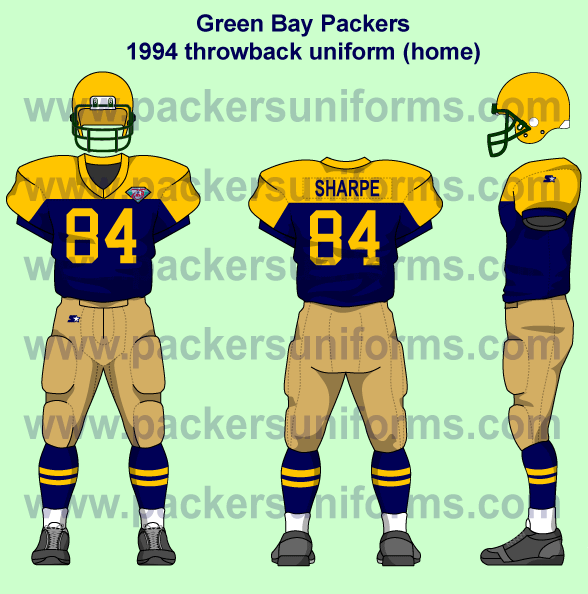
Click here for picture vs. Philadelphia.
Click here for picture vs. New England.
Click here for picture vs. Tampa Bay.
Throwback road uniform worn 10/31/1994 against Chicago:
White jersey with gold shoulders extending
to end of sleeves; navy name and numbers; NFL 75th Anniversary patch on
left chest; solid tan pants, blue socks; solid gold helmet (photo)
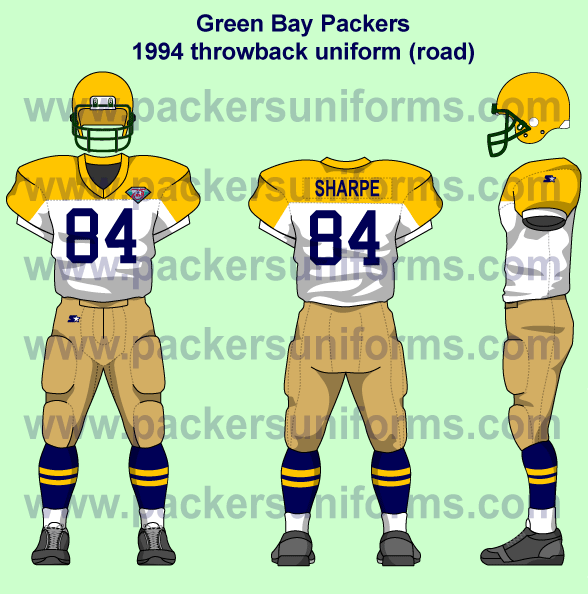
For this Halloween game, left tackle Ken Ruettgers added Jack o'Lantern graphics to his solid-gold helmet. Click
here for picture. (Pictures courtesy Paul Junio)
The throwback jerseys featured sewn-on tackle-twill numbers, which wouldn't return to the Packers' regular jerseys until the next season. |
| 1995 |
Silkscreen numbers replaced with sewn-on versions. |
| 1996 |
Super Bowl XXXI (Jan. 26, 1997): Special helmet decal worn to honor former Commissioner Pete Rozelle, who died December 6, 1996 – script "Pete" over the NFL shield. Click
here for picture. |
| 1997 |
Nike assumes uniform contract, swoosh replaces Starter logo on sleeves and front of pants
Sleeve stripes reduced from five to three (maintaining same gold/green/white/green/gold
configuration); NFL shield added to left thigh of pants (GBP03; 502)(photo)

Super Bowl XXII (Jan. 25, 1998): For the first time, Super Bowl logo patch worn on left chest. Click
here for picture.
|
| 1998 |
No new changes to uniform |
| 1999 |
No new changes to uniform |
| 2000 |
No new changes to uniform |
| 2001 |
Reebok acquires uniform contract for entire NFL, their logo replaces the swoosh on sleeves and front of pants
Helmets now painted with metallic, "pearlized" shade of gold
Throwback uniform for Thanksgiving game against Detroit:
solid white
jersey with green name and numbers, solid tan pants, solid gold helmet with
grey facemask, black shoes (photo, own) Click here for picture (Ahman Green).
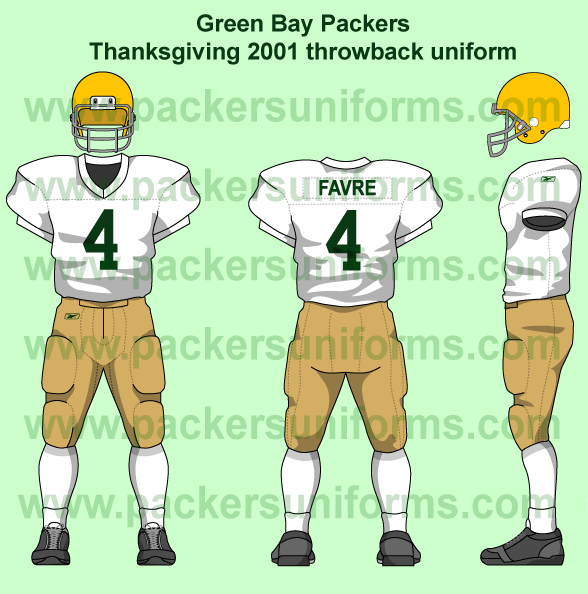
|
| 2002 |
"NFL EQUIPMENT" tag replaces NFL shield on jersey neck and front of
pants (GBP03; 502)(photo) 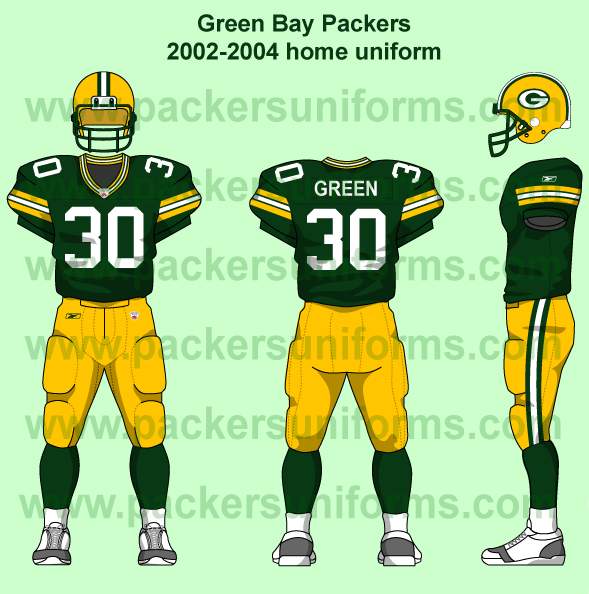
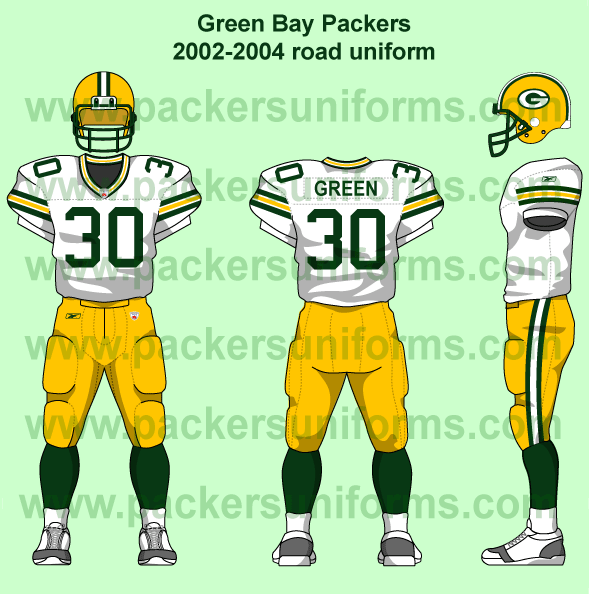
|
| 2003 |
Lambeau Field rededication patch worn 09/14/2003 (photo) Click
here for picture.
Throwback uniform for Thanksgiving game (09/27/2003) against Detroit:
white
jersey with green name and numbers, stripe pattern green/yellow/green (three
on collar, five on sleeve), gold pants with thin green/white/green stripes,
green socks with yellow/green/white/green/yellow stripes (repeated twice)
standard helmet with grey facemask, black shoes (photo)
"3" decal added to back of helmet for all games starting with December 7th (Week
13) to honor Tony Canadeo after his death. Click
here for picture. |
| 2004 |
"40" helmet decal worn for one game on September 19th (Week
2) against the Bears. This decal was worn by all 1,440 active players
to honor Pat Tillman, the first NFL player killed in combat since the
Vietnam War. Click
here for picture.
"92" decal added to back of helmet for all games starting with January
3rd (Week 17) to honor Reggie White after his death. Click
here for picture. |
| 2005 |
"FÚTBOL AMERICANO" helmet decal worn for one game on Monday Night Football, October 3rd (Week
4) at Carolina. This decal was worn by all NFL teams in Week 4 to commemorate the first time regular-season game played outside the United States — the Arizona Cardinals vs. San Francisco 49ers, played on October 2 in Mexico City's Estadio Azteca). Click
here for picture. |
| 2006 |
No new changes to uniform |
| 2007 |
Lambeau Field 50th Anniversary patch worn on home jerseys Click
here for picture.
Black "21" helmet decal worn by all teams in Week 14 game to honor murdered Washington safety Sean Taylor. Players are allowed to wear the decal for the remainder of the season. Click
here for picture.
Also in Week 14, the Dallas Cowboys chose to wear their blue throwback jerseys at home, putting the Packers in their road whites. Had the Packers worn their green jerseys in Dallas, the equipment staff would have removed the Lambeau Field patches and replaced them after the game (Story here)
NFL institutes a standardized uniform patch for team captains. Patch is square, bordered in gold, incorporating a sans-serif "C" above four white stars. Stars are colored gold, left to right, for each season of a captain's tenure (starting with 2007). For home jerseys, the "C" is white against a background of the jersey color (teams such as the Giants have standard blue and alternate red versions). For road jerseys the "C" is in team color against a white background.
The Packers (along with roughly one-third of the league) elect not to use the patches in the regular season, because they select captains on a game-by-game basis. The team selects captains for the entire post-season, though, and so the patches are added to Packers uniforms for the playoffs.
| 2008 |
Updated NFL shield introduced starting with the 2008 Draft. 
New shield appears on updated "NFL EQUIPMENT" tag on uniform.
After wearing white cleats in pre-season games, the Packers to black shoes for the regular season, the first time (excluding throwbacks) the team has worn black since 1974.
For the first game, a memorial patch for Gene Upshaw, deceased head of the players' union, is worn by all current players. Click here for picture (Will Blackmon) A similar helmet decal is worn for the entire season. Click here for picture (Donald Driver) |
| 2009 |
No new changes to uniform.
For October 5th Monday Night game in Minneapolis, certain Packers wear pink gloves, shoes and accessories as part of NFL initiative to raise breast cancer awareness. Special pink-ribbon logo is added to the back of helmets, and sideline gear is trimmed in pink. Click here for details.
As in 2007, the Packers eschew the League's captain patches during the regular season, but issue them for the playoffs. |
| 2010 |
New alternate uniform added, based on 1929 uniform, worn against the 49ers on December 5th: Navy jersey with navy numbers in large gold circle on chest, gold name and numbers on back. Canvas-colored pants, navy socks, brown helmet with gray facemask (to simulate leather helmet). The 1929 details have been updated to reflect current NFL uniform regulations: the circle, which was originally ~5 inches in diameter, has been enlarged, and the Reebok and NFL logos are retained in this uniform.
NFL regulations require each alternate to have a 5-season lifespan, so no other alternate can be introduced until 2015. Click here for a photo and more details.
Once again, the Packers eschew captain patches during the regular season, but issue them for the playoffs.
Super Bowl XLV (Feb. 6, 2011): Packers elect to wear their green home jerseys. A Super Bowl logo patch is added to the left chest. Click here for picture (Aaron Rodgers) |
| 2011 |
The Packers wear their throwback uniforms (now designated "re-created 1929 uniforms") on October 16th against the St. Louis Rams at Lambeau Field. |
|
